The Tudors Historical Inaccuracies Season 3
Jump to navigation
Jump to search
< Back home: <a href="/" target="_self">The Tudors Fan Wiki</a>
See also: The Tudors Depictions Throughout History | The Tudors Photos | The Tudors 100 Reasons to Watch | The Tudors Links & Resources 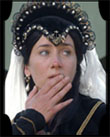 FACT OR FICTION? History buffs! Have you sniffed out a few historical inaccuracies within The Tudors drama? Whether minuscule or huge, catalogue them here to see how the show sizes up against British history. (Brief descriptions please - for more lengthy in-depth history see characters profiles and other individual pages on Site Map) Season 3
| |
| |
| According to The Tudors | According to History | |
| Henry introduces Ambassador Chapuys to his new queen Jane as if it's the first time she has ever met him. Episode 3:01 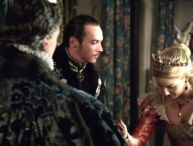 | Jane Seymour had been a lady-in-waiting to Queen Katherine of Aragon and Queen Anne Boleyn which means she had already come in contact with the Ambassador. In fact, when Henry had become enamoured of her while Anne was still queen, the Ambassador had coached Jane and as Alison Weir says : "The ambassador advised her to drop heavy hints about Anne's heretical leanings in Henry's ear, and to say that the people of England would never accept her as their true Queen. She must say these things in the presence of her supporters, who would all then swear, on their allegiance to the King, that she spoke the truth. Jane certainly acted upon this advice, and it had the desired effect upon the King, who was now receptive to criticism of his wife." | |
| Person or Event | Jane Boleyn (Lady Rochford) is appointed principal lady-in-waiting in the household of Queen Jane Seymour. This is done partially out of sympathy for what Lady Rochford had suffered from in the aftermath of he<a href="/page/Jane+Boleyn" target="_self">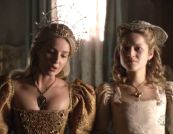 </a>r husband George Boleyn's execution and disgrace. </a>r husband George Boleyn's execution and disgrace.Episode: 3.01 | Jane Seymour's principal lady-in-waiting was actually her sister, Elizabeth Seymour. Jane Boleyn did continue to serve in the queen's household under Queen Jane, but not as principal lady-in-waiting. It is not known exactly when Jane returned to court after the execution of her husband or for how long she served before the queen's death in October, 1537. |
Jane Boleyn makes negative comments about the Pilgrims' uprising saying they want to take the country back to the dark ages as a criticism of the "old" Catholic religion. | Lady Rochford (Jane Boleyn) was herself a Catholic from a strong Catholic background which was possibly the reason she and her husband George Boleyn who was a reformer had an unhappy marriage. She would have been a supporter of the Pilgrims. | |
Robert Aske is portrayed by Gerard McSorley who is 59 years old. | Robert Aske was in his mid to late thirties, as his birth date is generally accepted as being circa 1500. | |
Sir Francis Bryan threatens Princess Mary Tudor saying if she was his daughter he would "smash your head against the wall until it was as soft as a boiled apple, you understand?" | Similar words were actually spoken by either Thomas Howard, 3rd Duke of Norfolk or the Earl of Shrewsbury, but the timing was before Queen Katherine of Aragon had even died. | |
Lady Ursula Misseldon is the mistress of Sir Francis Bryan & King Henry VIII<a href="/page/King+Henry+VIII" target="_self"> </a> </a> | This character is fictional and there is no definitive evidence that Henry had a mistress during the time he was married to Jane Seymour. There was some speculation that he may have had a dalliance with Anne Basset, one of her ladies in waiting, but even that was said to have happened after Jane's death. | |
| Sir John Constable is tortured with a hot poker by Edward Seymour | The historical character's name was Robert Constable and the torture incident is complete dramatic license, since he would not have survived to then have been beheaded as shown in the series. | |
Charles Brandon, 1st Duke of Suffolk was responsible for putting down the Yorkshire Rebellion | In reality, the Duke of Suffolk put down the Lincolnshire rebellion and it was Thomas Howard, 3rd Duke of Norfolk and the Earl of Shrewsbury who put down the lengthier Northern rebellion. Technically, only the Northern rising is considered part of the "Pilgrimage of Grace" whose main objective was to take back 'the Cross of Christ'. | |
Francis Bryan has an affair with the wife of Edward Seymour, Anne Stanhope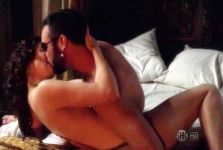 | It is true that Edward Seymour repudiated his first wife, Catherine Fillol for adultery, but he was married to Anne Stanhope by 1534. Rumors had it that Catherine Fillol's affair was with Edward's dad John Seymour. There is no record that Anne Stanhope was ever unfaithful to her husband. | |
Reginald Pole meets with Cardinal von Waldburg. The Cardinal tells Pole that the Holy Father has asked him to write a pamphlet denouncing the king and plans to elevate Pole to the title of Cardinal.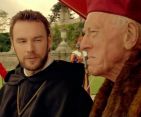 | In reality, Henry asked Pole to write down his thoughts on his supposed unlawful marriage to Queen Katherine of Aragon. With reluctance, Pole agreed and came back with an unexpected diatribe titled Pro ecclesiasticae unitatis defensione | |
| Francis Bryan is not seen at court until Season 3 at the wedding of Henry VIII and Jane Seymour. | Although he had been removed from the Privy Chamber in 1519 and again in 1526, Sir Francis Bryan replaced Sir William Carey in the Privy Chamber in 1528 thanks to the influence of his cousin Anne Boleyn. He remained an influential companion to the king, even during Anne Boleyn's downfall (he earned his nickname,"The Vicar of Hell," due to his cruel abandonment of Anne), and worked closely with Cromwell to bring about her demise. | |
Cardinal Von Waldburg is played by the great actor Max Von Sydow, who is 80 years old.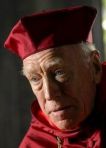 | The historical character was in his early 20s in the 1530s, as he was born in 1514. | |
| Charles Brandon, 1st Duke of Suffolk and Sir Francis Bryan bring Katherine Howard to court. Sir Francis Bryan discovers Katherine Howard in Lambeth Palace, which is run as a ***** house of "aristocratic bastards" by Agnes Tilney, Dowager Duchess of Norfolk. 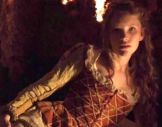 Episode 6 | Katherine Howard's uncle, Thomas Howard, 3rd Duke of Norfolk secured her a position as lady-in-waiting to Anne of Cleves. We do not know exactly when she caught the king’s eye. Katherine Howard was recommended to the King by her uncle Thomas Howard, 3rd Duke of Norfolk and Agnes Tilney. Historians have described the antics of the young women living with Agnes Tilney to have been LIKE a ***** house, but the Dowager Duchess either ignored or was unaware of the extent of the indecencies occurring under her own roof. | |
| Charles Brandon, 1st Duke of Suffolk and Edward Seymour head up the faction to take down Cromwell | Cromwell had several enemies at court but the two biggest were Thomas Howard, 3rd Duke of Norfolk and Bishop Stephen Gardiner. | |
Margaret Pole, Lady Salisbury is shown has having been executed with the rest of her family in 1538 (before Katherine Howard was made queen).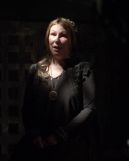 | In fact she was removed to the Tower in 1538 and was there, for nearly two years, she was "tormented by the severity of the weather and insufficient clothing". Queen Katherine Howard sent her warm clothing and appealed for her. It was thought that she may have been released but in April 1541, there was another insurrection and finally despite the popularity of the Countess,the inevitable penalty was invoked and on May 27th 1541, she was sent to the scaffold to suffer a barbaric death at the age of 67. | |
When Henry introduces his daughters to his new wife Anne of Cleves he refers to them as "Princess Mary" & "Princess Elizabeth"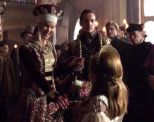 | Mary & Elizabeth were still referred to as "Ladies" as Henry still considered them bastards and they were not properly installed in the line of succession until shortly before his death. | |
| The year is shown as 1538 and the location as Cheapside in London. According to The Tudors, leading Protestant Robert Packington is shot dead in broad daylight on a crowded thoroughfare after demanding arrogantly that some common man get out of his way. | Robert Packington was shot around 4 am on November 13th on one of the foggiest mornings in living memory as he crossed a deserted Cheapside on his way to morning mass at the Mercer's Chapel nearby. No one witnessed the murder although labourers in Soper Street heard the shot. It was in 1536 and probably at the command of disgruntled clergy opposed to Cramner's and Cromwell's new Protestant Church. Lady Rose Locke-Hickman writes vividly about it in her own memoirs, and how frightened it made her mother as it happened almost outside of her own house | |
In episode 5 Aske is held in "York Castle" in England. | The picture of "York Castle" is actually of the Rock of Cashel in Ireland, a religious site and stronghold of Irish kings. NOTE to posting : All set locations are filmed in Ireland - see this page Set Locations Of The Tudors | |
In Episode 5 the king is asked for permission to perform a Caesarean on the queen but he remains silent. After the birth he laments her death by "Childbed fever".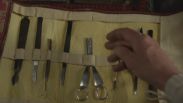 | In fact Henry did authorize a Caesarean of which Jane Seymour died a few days later. NOTE to posting : There is no evidence that Jane Seymour underwent a C section which would have meant an immediate death sentence. She died 12 days later. Please see Controversies about Jane Seymour Rebuttal: My info comes from The Lives of the Kings and Queens of England edited by Antonia Fraser, pg 189, 1975 edition. Info on the controversies page above has a quote from Antonia Fraser's book "The Six WIves of Henry VIII" originally published in 1992 and reissued in 2002 where she states categorically that it was not a C section. | |
The Earl of Shrewsbury is depicted in the series as a much younger man and could easily be mistaken for his son, Francis.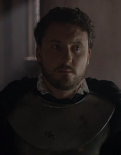 | At the time of the Pilgrimage of Grace in 1536, when he joined the 3rd Duke of Norfolk at Doncaster, he was 70 yrs old. The earl died in 1538. Those dates confirm that he had to have been the 4th Earl of Shrewsbury; as titles are passed on after a noble dies. | |
Jane Seymour is portrayed by beautiful actress, Annabelle Wallis. | Jane was said to be not plain, but not everyone would marry her for love. In my opinion, everyone would marry Annabelle for love! | |
Duke Phillip of Bavaria is in love with Princess Mary Tudor and she returns those feelings.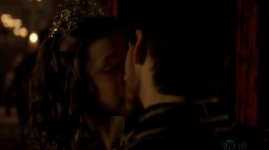 | In reality, Phillip loved Mary but she didn't return those feelings. The only Phillip she loved was Phillip of Spain, who felt different about her. (Deja vu?)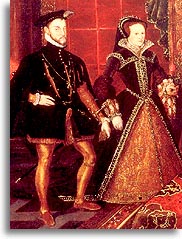 | |
There are a lot of crowns and not many headdresses (not in Anne of Cleves's case).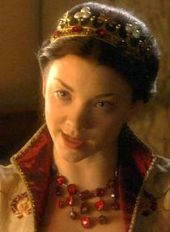 | Headdresses were even worn by queens. Crowns were very uncommon for queens. See: Hoods & Headdresses on the Tudors Crowns on the Tudors Tiaras of the Tudor Ladies | |